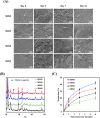3D-printed magnesium/strontium-co-doped calcium silicate scaffolds promote angiogenesis and bone regeneration through synergistic bioactive ion stimulation
- PMID: 40544274
- PMCID: PMC12182697
- DOI: 10.1186/s13036-025-00528-6
3D-printed magnesium/strontium-co-doped calcium silicate scaffolds promote angiogenesis and bone regeneration through synergistic bioactive ion stimulation
Abstract
Bone defects resulting from trauma, infection, or surgical resection require biomaterials that support osteogenesis and vascularization for effective regeneration. In this study, we developed a 3D-printed magnesium- and strontium-co-doped calcium silicate (MSCS) scaffold using direct ink writing to optimize its bioactivity and structural integrity. X-ray diffraction confirmed the successful incorporation of Sr and Mg, leading to phase modifications that influenced ion release and degradation. Wettability and mechanical testing showed that Sr improved the stability, while Mg accelerated degradation, with M5S5 co-doping exhibiting a balanced degradation profile. In vitro, Wharton's jelly mesenchymal stromal cells cultured on M5S5 scaffolds displayed enhanced proliferation, cytoskeletal organization, and osteogenic differentiation, as evidenced by increased alkaline phosphatase activity and bone matrix protein expression. Angiogenesis assays using human umbilical vein endothelial cells revealed that Sr and Mg co-doping synergistically enhanced vascular endothelial growth factor and angiopoietin-1 secretion, thereby promoting endothelial tube formation. In vivo micro-computed tomography and histological analysis of a rabbit femoral defect model confirmed that M5S5 facilitated extensive new bone formation, exhibiting superior trabecular architecture and mineralization. These findings highlight MSCS scaffolds as promising biomaterials for bone tissue engineering applications.
Keywords: 3D printing; Bone regeneration; Calcium silicate; Magnesium; Strontium.
© 2025. The Author(s).
Conflict of interest statement
Declarations. Ethics approval and consent to participate: Not applicable. Consent for publication: Not applicable. Competing interests: The authors declare no competing interests.
Figures












Similar articles
-
Strontium oxide-functionalized 3D-printed polycaprolactone/β-tricalcium phosphate nanocomposite scaffolds with osteogenic microenvironment remodeling for accelerated bone regeneration.J Mech Behav Biomed Mater. 2025 Jul 31;172:107146. doi: 10.1016/j.jmbbm.2025.107146. Online ahead of print. J Mech Behav Biomed Mater. 2025. PMID: 40780041
-
Mineralized osteoblast-derived exosomes and 3D-printed ceramic-based scaffolds for enhanced bone healing: A preclinical exploration.Acta Biomater. 2025 Jun 15;200:686-702. doi: 10.1016/j.actbio.2025.05.051. Epub 2025 May 21. Acta Biomater. 2025. PMID: 40409510
-
The impact of graphene quantum dots on osteogenesis potential of Wharton's jelly mesenchymal stem cells in fibrin hydrogel scaffolds.Cytotechnology. 2025 Feb;77(1):14. doi: 10.1007/s10616-024-00672-9. Epub 2024 Dec 10. Cytotechnology. 2025. PMID: 39665046
-
Strategies in Electrospun Polymer and Hybrid Scaffolds for Enhanced Cell Integration and Vascularization for Bone Tissue Engineering and Organoids.Wiley Interdiscip Rev Nanomed Nanobiotechnol. 2024 Nov-Dec;16(6):e2022. doi: 10.1002/wnan.2022. Wiley Interdiscip Rev Nanomed Nanobiotechnol. 2024. PMID: 39696966 Review.
-
Vat photo-polymerization 3D printing of gradient scaffolds for osteochondral tissue regeneration.Acta Biomater. 2025 Jun 15;200:67-86. doi: 10.1016/j.actbio.2025.05.042. Epub 2025 May 23. Acta Biomater. 2025. PMID: 40414264 Review.
References
-
- Zheng H, Zhou Y, Zheng Y, Liu G. Advances in hydrogels for the treatment of periodontitis. J Mater Chem B. 2023;11:7321–33. - PubMed
-
- Liu Z, He X, Chen S, Yu H. Advances in the use of calcium silicate-based materials in bone tissue engineering. Ceram Int. 2023;49:19355–63.
Grants and funding
LinkOut - more resources
Full Text Sources
Research Materials

